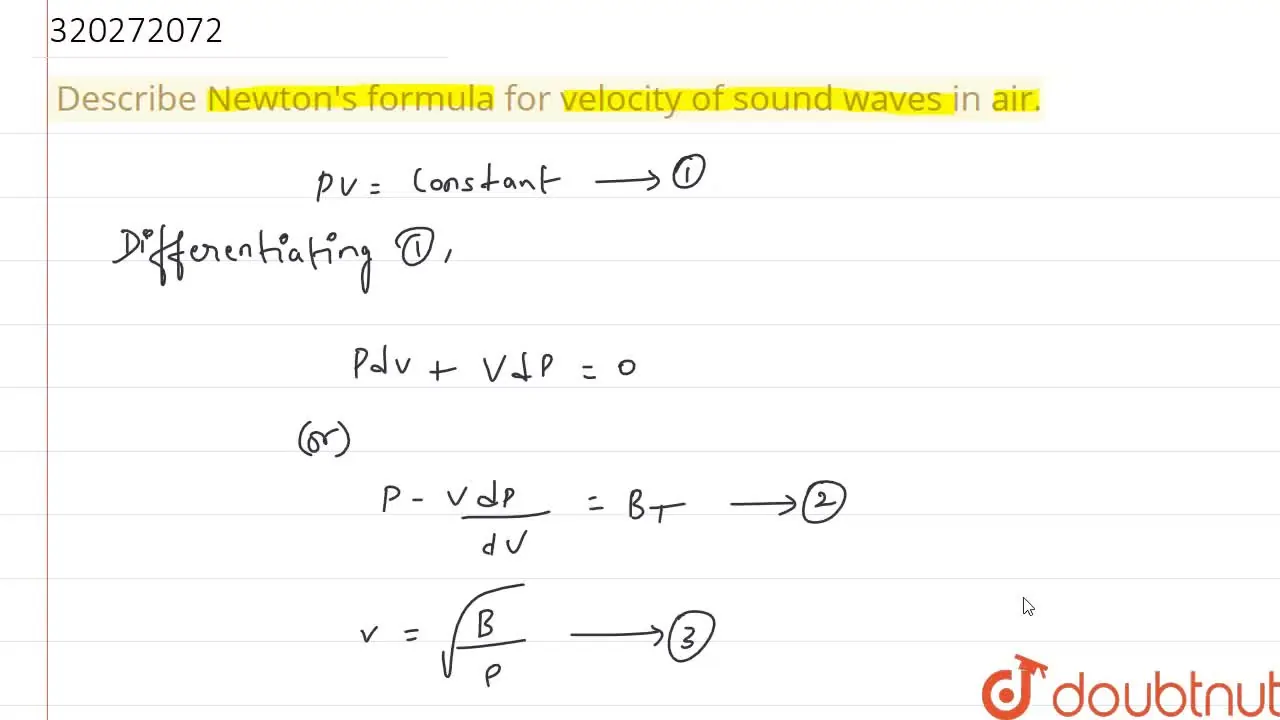Describe Newton's formula for velocity of sound waves in air.Solution in Tamil
Newton assumed that when sound propogates in air, the formation of compression and rarefaction takes place in very slow manner so that the process is isothermal in nature. That is, the heat produced during compression (pressure increases, volume (decreases), and heat lost during rarefaction (pressure decreases, volume increases) occur over a period of time such that the temperature of the medium remains constant. Therefore, by treating the air molecules to form an ideal gas, the changes in pressure and volume obey Boyle's law, Mathematically
PV= Constant ................(1)
Differentiating equation (1), we get
pdV + VdP=0
or, P=−VdPdV=BT .................(2)
where, BT is an isothermal bulk modulus of air.
Substituting equation (2) in equation v=√Bp, the speed of sound in air is
vT=√BTρ=√Pρ............(3)
Since P is the pressure of air whose value at NTP (Normal Temperature and Pressure) is 76 cm of mrercury, we have
P=(0.76×13.6×103×9.8)Nm−2
ρ=1.293kgm−3, here ρ is density of air
Then the speed of sound in air at Normal Temperature and Pressure (NTP) is
vT=√0.76×13.6×103×9.81.293
=279.80ms−1≈280ms−1 (theoretical value)
But the speed of sound in air at 0∘ C is experimentally observed as 332ms−1 which is close upto 16% more than theoretical value (Percentage error is 332−280332×100%=15.6%)
This error is not small.
Laplace assumed that when the sound propagates through a medium, the particles oscillate very rapidly such that the compression and rarefraction occur very fast. Hence the exchange of heat produced due to compression and colling effect due to rarefraction do not take place, because, air( medium) is a bad conductor of heat. Since, temperature is no longer considered as a constant here, sound propogation is an adiabatic process. By adiabatic consideratios, the gas obey's Poisson law (not Boyle's law as Newton assumed), which is
PVY = constant ............(4)
where, λ=CpCv, which is the ratio between specific heat at constant pressure and specific heat at constant volume.
Differentiating equation (4) on both the sides, we get
VtdP+P(λVt−1dV)=0
or λP=−VdPdVBA............(5)
where, BA is the adiabatic bulk modulus of air. Now, substituting equation (5) in equation
v=√Bρ, the speed of sound in air is
vA=√BAρ=√λPρ=√λvT...........(6)
VA=331ms−1.
Related Playlists
- BOOK - SURA PUBLICATIONCHAPTER - WAVES EXERCISE - NUMERICAL PROBLEMS:13videos
WAVES
- BOOK - SURA PUBLICATIONCHAPTER - WAVES EXERCISE - CONCEPTUAL QUESTIONS:6videos
WAVES
- BOOK - SURA PUBLICATIONCHAPTER - WAVES EXERCISE - VALUE BASED QUESTIONS2videos
WAVES
- BOOK - SURA PUBLICATIONCHAPTER - SURAS MODEL QUESTION PAPER -2 ( PHYSICS )EXERCISE - PART - IV10videos
SURAS MODEL QUESTION PAPER -2 ( PHYSICS )
- BOOK - SURA PUBLICATIONCHAPTER - WORK, ENERGY AND POWER EXERCISE - VALUE BASED QUESTIONS5videos
WORK, ENERGY AND POWER
Similar Questions
The speed of a wave in a certain medium is 900 m/s. If 3000 waves passes over a certain point of the medium in 2 minutes, then compute its wavelength.
04:13View SolutionWhy is it that transverse waves cannot be produced in a gas? Can the transverse waves be produced in solids and liquids?
05:25View Solution(i) What is the science (physics concept) behind a stethoscope? What is the principle?
(ii) How will you make a child to understand the, Intensity of light or sound From Density without using formulae.View SolutionWrite the expression for the veloctiy of longitudinal waves in an elastic medium.
03:55View SolutionRamu and Raju are dragging water in a bucket from the wells A and B respectively. Ramu dragged three buckets of water within 5 minutes but Raju could not do for the short interval of time. He could take only two buckets of water in 7 minutes. What do you inter from this Incidence.
What is the Expression for Work or Energy ?11:47View Solutionवायु में ध्वनि की चाल के लिये न्यूटन का सूत्र लिखिये इस पर दाब के परिवर्तन का क्या प्रभाव पड़ता है?
03:55View SolutionComment on Laplace correction to Newton's formula for velocity of sound in air.
03:55View SolutionIn deriving Newton's formula for velocity of sound, the changes in volume of air are assumed to be
02:24View SolutionDescribe Newton's formula for velocity of sound waves in air.
01:45View SolutionDiscuss Newton’s formula for velocity of sound in air medium and apply Laplace’s correction.
06:46View SolutionDescribe Newton's formula for velocity of sound waves in air.
03:34View SolutionDescribe Newton's formula for velocity of sound waves in air.
05:14View SolutionIn deriving Newton's formula for the velocity of sound, the changes in volume of air are assumed to be _________
05:24View Solution(A): The error in Newton's formula of velocity of sound in air was 16%.
(R): The experimental value of velocity of sound in air at 0∘C is 331m/sView SolutionExplains Newton's formula for velocity of sound. What is it's limitation?
OR
Why Newton's formula for velocity of sound was inadequate?11:47View Solution


